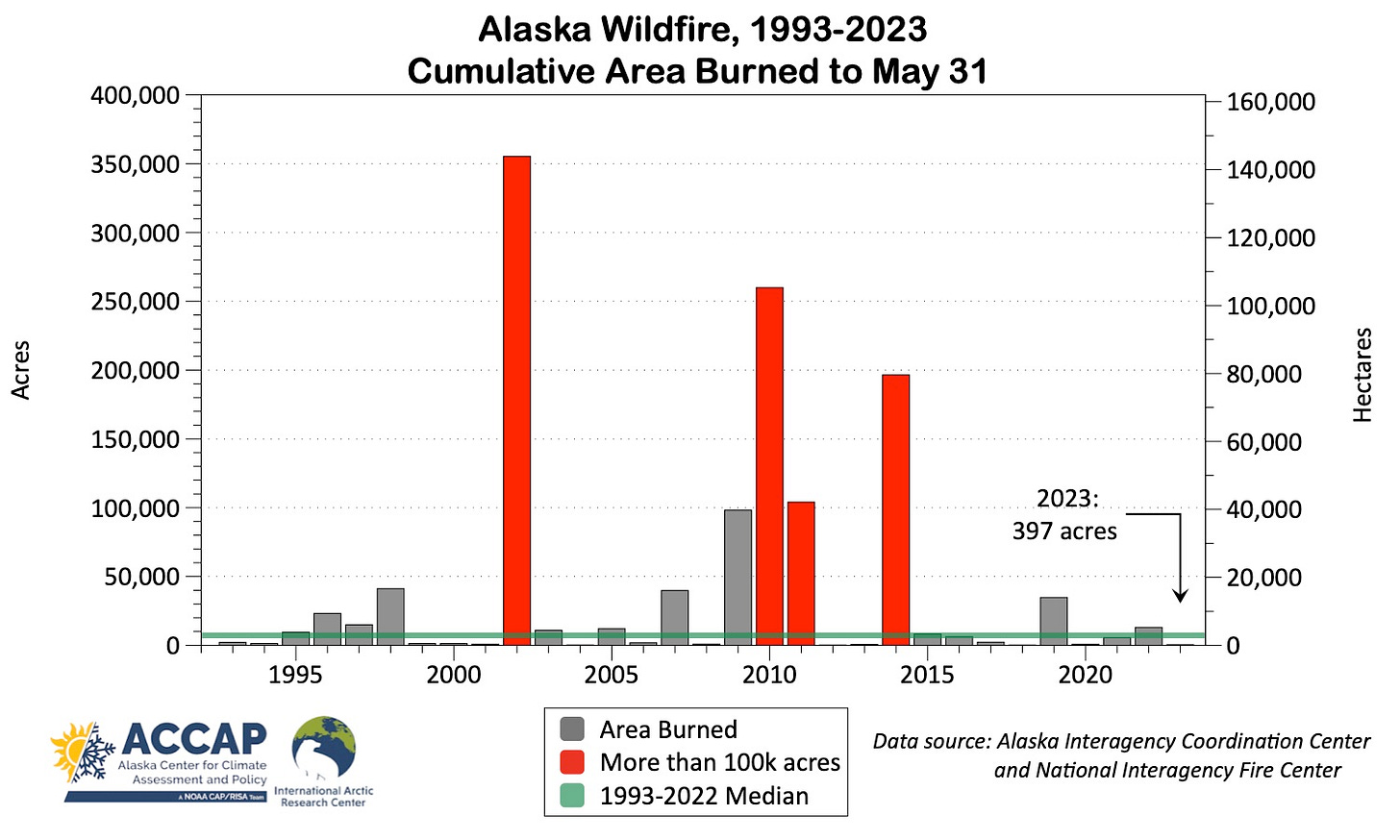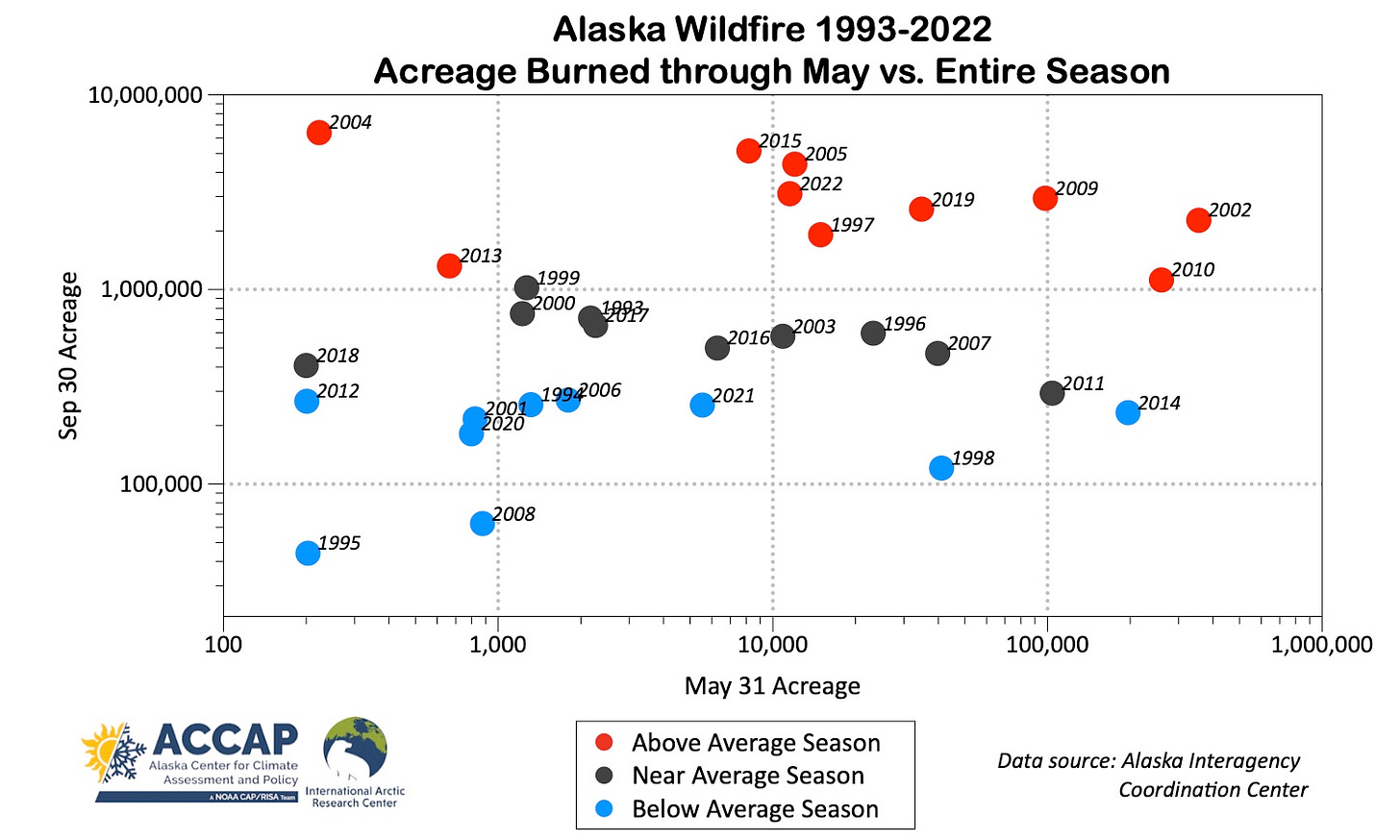The effects of the near record cold April and a May weather pattern that kept storminess in the southern Bering Sea region reverberated through the Bering and Chukchi Seas late spring sea ice. For more details see the May 25th Late Spring 2023 Sea Ice post. At the monthly scale, the Bering Sea average daily sea ice extent for May in the National Snow and Ice Data Center data, plotted in Fig. 1, was the highest since 2013, though only very slightly higher than 2021. Prior to 2013 this would have been a pretty typical May as far as ice extent goes. In the Chukchi Sea, May ice melt was also slow and the average daily ice extent was the highest since 2012.

While the May 2021 and 2023 Bering Sea average ice extent were very similar, the distribution of the late spring ice was quite different, as seen in Fig. 2. This year (left) the sea ice persisted much farther south than 2021 (right), and even at the end of the month there was still a little ice south of 60N. This May also saw much more open water in the Gulf of Anadyr than in 2021. These differences may be significant at the ecosystem level from ice algae to walrus riding the ice north through the Bering Strait, and the persistent southern ice may help strengthen the Bering Sea cold pool in this area. NOAA NMFS Race Division will be doing the annual bottom trawl survey in the coming weeks so we’ll get a comprehensive picture of bottom temperatures later this summer.

Wildfire
With the very cold April and late snowmelt over most of the wildfire-prone areas in Alaska, it’s no surprise that the wildfire season has started off quite slow in Alaska. Virtually all of the 397 acres (161 ha) that has burned is the result of human started fires. This is typical for May, as the mainland Alaska thunderstorm season does not typically ramp up until the last days of the May or early June.

To the east of Alaska, in the Yukon Territory, wildfire activity has also been low through the end of May, with 1156 acres (468 ha) burned. It’s a completely different scenario in the Northwest Territories, especially south of Great Slave Lake, where there have been several large wildfires, due in part to early snow melt and record strong high pressure aloft. All together, nearly 500,000 acres (200,000 ha) burned in the NWT in May. For context, that’s more than the total acreage burned in the NWT for the entire season 2018 through 2021.
Wildfire in May occasionally burns a lot of acreage in Alaska, but active or not, May wildfire is not predictive of the rest of the season. Figure 4 plots the total area burned to May 31 vs. the September 30 (end-of-season) total. It’s clear that there is no correlation between the these two quantities. For example, 2004 had very little wildfire in May but finished up as the largest season on record, while May 2014 saw saw nearly 200,000 acres burn (nearly all of that in the Funny River fire on the Kenai Peninsula) but the season still finished up in the “significantly below average” category.

Technical details:
NSIDC Arctic Sea Ice information and data available at https://nsidc.org/arcticseaicenews/
AMSR2 data and images from U. Bremen at https://seaice.uni-bremen.de/sea-ice-concentration/amsre-amsr2/
The Alaska Interagency Coordination Center is the first stop for all things wildfire-related in Alaska: https://fire.ak.blm.gov
Up-to-date wildfire information for the Yukon Territory at https://wildfires.service.yukon.ca and for the Northwest Territories at https://www.gov.nt.ca/ecc/en/services/wildfire-update
Housekeeping note
I’ve been writing the Alaska and Arctic Climate newsletter for six month now. The newsletter has over 400 subscribers and the “open rate” is over 60 percent, which seems pretty good for what’s quite a niche subject area. It’s also useful to have these posts handy for other aspects of my work, so I’ll continue to produce this newsletter. If you have any suggestions for improvements or topics you would like to see covered in future newsletters feel free to comment at any time and I’ll see what I can do.




Rick. You sure have many good sources. Very interesting.
Any idea about what may have been the largest fire in recorded times in SE Alaska ?
Also, please pass on to Brian Brettschneider that I found the original letter from Ralph Lane (Mile 47 Camp observer, 2/7/63).